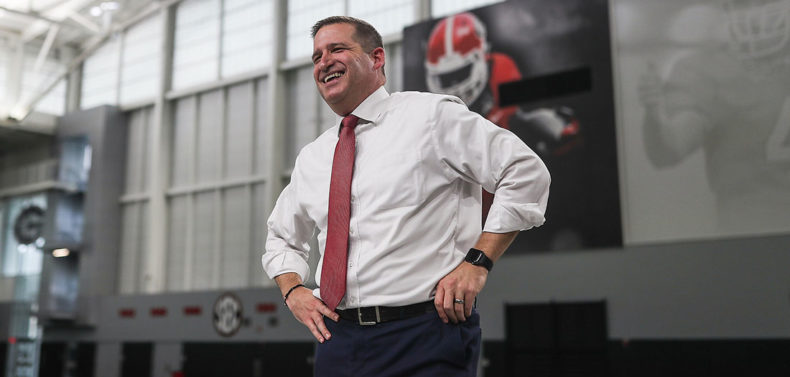There are many things to worry about in today’s world, but one of them is not the financial health of the University of Georgia Athletic Association.
The association—the nonprofit corporation that runs UGA’s football and other NCAA sports teams—posted a whopping $46.3 million surplus in the 2021 fiscal year, with about $169.1 million in revenue and $122.7 million in operating expenses. UGA reported the surplus in its mandatory annual “NCAA Membership Financial Report,” posted on the athletic association’s website, georgiadogs.com.
According to a USA Today analysis, that was twice the surplus any other university reported for the 2021 fiscal year, which included the COVID-plagued 2020 football season. Many highly successful college sports operations even reported steep drops in revenue in the 2021 fiscal year. The University of Texas reported $153 million in sports revenue, for example, down from $201 million in the 2020 fiscal year.
Most of that $46.3 million surplus is an illusion, an artifact of the NCAA’s reporting requirements, Athletic Director Josh Brooks told the association’s trustee board at its recent spring board meeting and three-day retreat at Greene County’s Ritz-Carlton Reynolds on Lake Oconee. (Fall and winter meetings of the association’s board are scheduled around home football or basketball games, but the longer spring meetings are held at a Georgia resort location with good golf courses.) Most of the surplus went to help pay off the costs of recent athletic association construction projects, including a recently completed $80 million project that added 136,300 square feet to the association’s Butts-Mehre Heritage Hall, Brooks said.
UGA has posted surpluses with clockwork regularity for decades, ever since Joel Eaves left Auburn to become UGA athletic director, bringing young Vince Dooley with him to coach the football team. Those surpluses have grown enormously in the last few years, however. The athletic association’s operating surplus was about $40 million in fiscal 2020 and $31 million in 2019, according to the university’s NCAA financial reports. In 2016, the surplus was a mere $7.2 million.
As a 501(c)3 corporation, exempt from federal income taxes, the association can’t post a profit and distribute dividends to anyone, but must spend its money. Much of that has gone into construction; the athletic association has spent $175 million on football-related facilities since Kirby Smart became football coach in 2016, reported the Atlanta Journal-Constitution last year. That doesn’t count tens of millions spent on other sports facilities, nor the next big project in the pipeline: a $68.5 million upgrade in parts of Sanford Stadium. Plans are to widen some congested concourses, add concession areas and restrooms, and build new and pricey luxury seating in what is now the press box. The athletic association board approved the Sanford Stadium project without dissent at May’s retreat, along with a record $162.5 million budget.
The athletic association also spent about $8.3 million in debt payments on about $82 million in debt in 2021, according to the NCAA report.
The UGA president chairs the board and controls a majority of its appointments, in compliance with an NCAA requirement that presidents have control of their school’s athletic programs.
The new budget shows where some of the projected 8 percent revenue increase will go. Compensation for football coaches, $11 million in the fiscal 2022 budget, is listed at $15.4 million in the FY23 budget. One assistant football coach will be making $2 million, and Smart stands to get a big raise after he led the team to UGA’s first football national championship since Herschel Walker carried Dooley’s Dawgs to that pinnacle 41 years ago. According to speculation in sports media, Smart could see his pay go up from $7.1 million to $10 million or more.
As usual, the adopted budget predicts normal operating losses for all but two of UGA’s 21 NCAA sports, football and men’s basketball. Men’s basketball brought in $2.2 million more than its $7.1 million expense in FY 2021. All the other sports operated with a combined loss of $21.6 million. Those expenses across all sports include $12 million for the equivalent of about 292 athletic scholarships distributed among 507 students on athletic aid. The so-called non-revenue sports, except for women’s basketball, are allowed to award partial scholarships.
The athletic association annually transfers some of its revenue for the use of the academic part of the university—$4.6 million in 2021.
Football gets the lion’s share of scholarships, a maximum of 85, per NCAA rules. But it’s also football that pays the freight in college sports. Football expenses were $49.2 million less than revenue in 2021, according to UGA’s NCAA financial report.
Next year, football is budgeted to bring in $34.7 million in ticket revenue, along with about $30 million in gifts to the association’s Hartman Fund. Gifts are tied to football seating and ticket priorities.
The biggest revenue stream comes through the Southeastern Conference, which is expected to allocate about $48.9 million to UGA in fiscal 2023. That’s money mainly from TV contracts for football and basketball and a handful of other sources, such as the SEC football and basketball championships.
If anything seriously falls through, the athletic association has plenty of cushion. The association has been investing some of that surplus revenue—at the end of June 2021, it had $45 million in a quasi-endowment managed by the UGA Foundation and a $52 million scholarship endowment, according to the athletic association treasurer’s report at the Ritz-Carlton meeting. The association has about $64.6 million in uncommitted reserve funds, said UGA Vice President for Finance and Administration Ryan Nesbit, the athletic association’s treasurer. Returns on those investments are projected to contribute $3 million to next year’s $162.5 million revenue budget.
Although UGA’s athletic financial picture is rosy now, recent changes in student-athletes’ rights are changing the college sports business model in ways that still aren’t clear. A 2021 Supreme Court decision decreed that student athletes have the right to get paid for the use of their name, image and likeness, or NIL, in advertisements or endorsements. Athletes still can’t get paid for playing, however.
The NCAA has also made it easier for disenchanted athletes to transfer to new schools with a so-called “transfer portal.” Last year the NCAA went even further, eliminating a requirement that athletes must sit out a year when they transfer unless they get a waiver from their old school.
Thousands of athletes have now taken advantage of the loosened transfer rules, some perhaps to pursue better NIL deals. At some colleges, syndicates called “collectives” have sprung up to raise NIL money. Alabama’s Nick Saban ignited a rare public spat among coaches last month when he accused Texas A&M of using NIL money to buy the nation’s top football recruiting class.
Now coaches and athletic administrators are clamoring for new rules and federal legislation to regulate the emerging NIL era. Whatever new rules or legislation emerge, UGA President Jere Morehead is positioned to play a central role, and is uniquely qualified for this particular set of issues.
Before becoming UGA president in 2014, Morehead taught business law at UGA and was for many years one of the co-authors of a widely used college textbook called “The Legal and Regulatory Environment of Business”—now in its 19th edition, though Morehead is no longer one of the authors.
Morehead is also the president of the Southeastern Conference, which like the UGA Athletic Association is a 501(c)3 nonprofit corporation, and chairs the high-level NCAA Board of Directors, which last month issued “guidance” about the NIL “environment” and recruiting. The guidance instructed schools to begin looking for violations of recruiting rules and clarified somewhat how schools can interact with the NIL collectives.
“While the NCAA may pursue the most outrageous violations that were clearly contrary to the interim policy adopted last summer, our focus is on the future,” Morehead said in a press release announcing the guidance.
Like what you just read? Support Flagpole by making a donation today. Every dollar you give helps fund our ongoing mission to provide Athens with quality, independent journalism.










